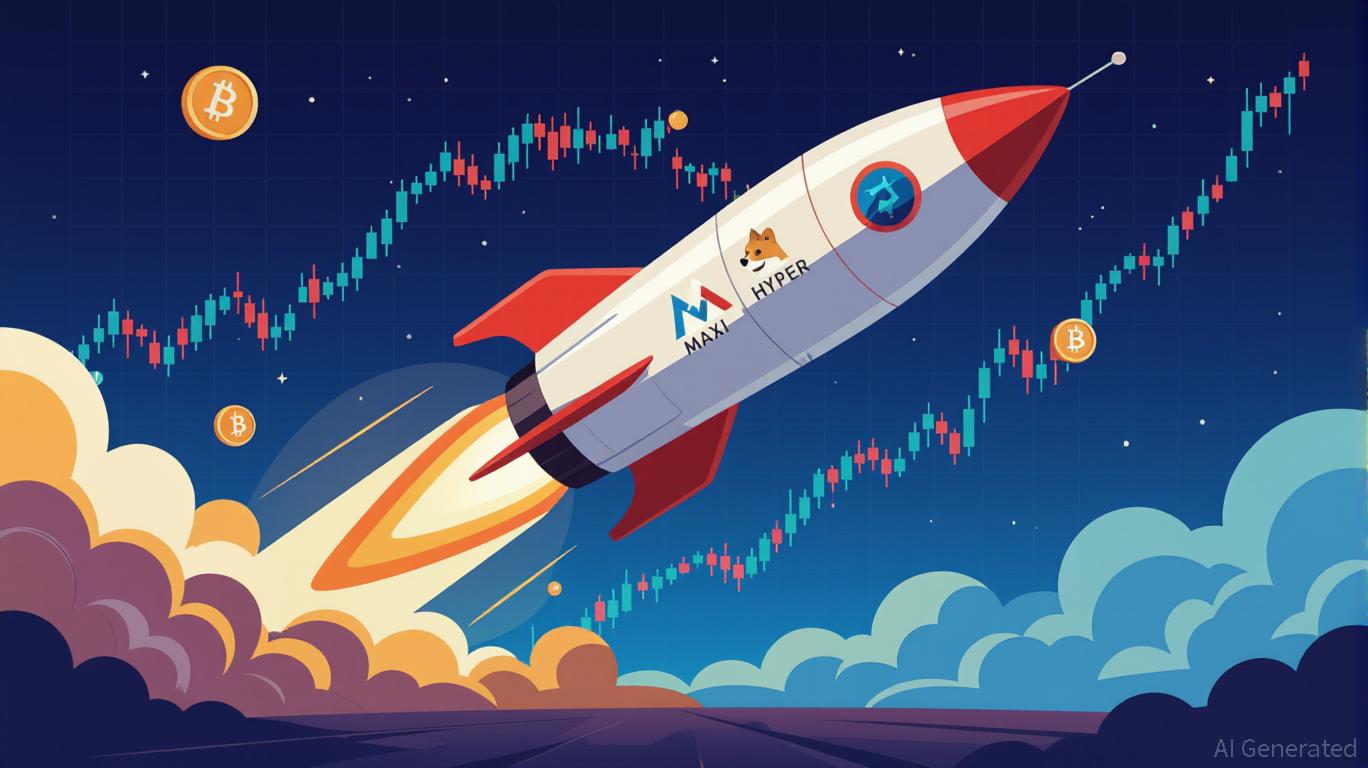Nvidia Earnings and Bitcoin: Assessing the Fading Correlation in a Shifting Market
- Nvidia and Bitcoin's historical correlation weakened from 0.80 to 0.36 in Q2 2025 as macroeconomic factors and regulatory risks overshadowed tech-sector momentum. - Bitcoin's post-earnings volatility spiked to 38% in Q2 2025, diverging from its typical pattern despite Nvidia's $46.7B revenue surge and AI growth forecasts. - Geopolitical risks (e.g., China export restrictions) and Bitcoin's unique drivers (halving, ETF approvals) now independently shape crypto markets. - Investors are advised to diversify
The relationship between Nvidia's quarterly earnings and Bitcoin's price action has long been a focal point for investors seeking to navigate the intersection of tech and crypto markets. For years, the two assets moved in sync, with Bitcoin often surging after Nvidia reported strong results. But recent data suggests this correlation is fraying, raising critical questions about the sustainability of the tech-crypto link in a rapidly evolving landscape.
The Historical Link: A Symbiotic Boom
From Q1 2023 to Q2 2025, Bitcoin posted positive price action in 7 out of 10 quarters following Nvidia's earnings reports. This pattern emerged as Nvidia's dominance in AI infrastructure—driven by surging demand for GPUs in data centers and AI training—became a bellwether for broader tech-sector optimism. Investors interpreted strong Nvidia results as a green light for risk assets, including Bitcoin.
For example, in Q2 2025, Nvidia reported $46.7 billion in revenue (up 56% YoY) and $1.05 in adjusted EPS, far exceeding expectations. Yet, while Bitcoin initially dipped to a seven-week low of $110,000 post-earnings, it quickly rebounded to $112,760. This volatility highlighted a growing disconnect: Bitcoin's short-term reaction diverged from its historical pattern, even as Nvidia's long-term narrative of AI-driven growth remained intact.
The Divergence: Why the Tech-Crypto Link Is Fraying
Several factors are eroding the once-strong correlation:
Macroeconomic Uncertainty Overshadows Tech Optimism
The broader market's sensitivity to Federal Reserve policy and inflation data has diluted the impact of individual earnings reports. For instance, Bitcoin's post-earnings dip in Q2 2025 coincided with anticipation of U.S. GDP figures and jobless claims, which overshadowed Nvidia's results.Regulatory and Geopolitical Headwinds
Nvidia's H20 chip sales to China—a potential $50 billion opportunity—remain stalled due to U.S. export restrictions. While the company's Q3 2025 guidance of $54 billion excluded China-related sales, the geopolitical uncertainty weighed on investor sentiment, indirectly affecting crypto markets.Bitcoin's Unique Fundamentals Take Center Stage
Bitcoin's price is increasingly driven by its own cycle, including halving events, regulatory developments (e.g., ETF approvals), and on-chain metrics. For example, the 2024 halving event and the SEC's delayed rulings on spot Bitcoin ETFs created independent tailwinds for crypto, reducing reliance on tech-sector momentum.Crowded AI Trades and Market Fatigue
As AI stocks like Nvidia became crowded trades, investors began to differentiate between AI-driven growth and broader tech-sector narratives. Bitcoin, meanwhile, faced its own challenges, with AI-themed tokens like Bittensor (TAO) and FET failing to rally in sympathy with Nvidia's performance.
The Data: A Closer Look at Post-Earnings Reactions
Nvidia's Q2 2025 earnings triggered a 38% spike in Bitcoin's daily volatility, the highest since early 2023. Yet, this volatility was short-lived. Within 48 hours, Bitcoin stabilized, trading 1.3% higher as the market digested Nvidia's guidance for $3–$4 trillion in AI infrastructure spending by 2030.
The key takeaway? While Nvidia's earnings still influence risk appetite, Bitcoin's trajectory is now shaped by a broader set of variables. This is evident in the weakening correlation coefficient between the two assets, which dropped from 0.80 in early 2024 to 0.36 in Q2 2025.
Investment Implications: Navigating the New Normal
For investors, the fading correlation between Nvidia and Bitcoin demands a nuanced approach:
Diversify Exposure to Tech and Crypto Narratives
Rather than treating Nvidia's earnings as a proxy for Bitcoin's direction, investors should evaluate each asset's fundamentals. For example, while Nvidia's AI dominance supports long-term tech growth, Bitcoin's near-term prospects hinge on macroeconomic data and regulatory clarity.Hedge Against Divergent Volatility
The post-earnings volatility in Q2 2025—where Bitcoin's daily volatility spiked to 38%—underscores the need for hedging strategies. Options with negative 25-delta skews (as seen in Q2 2025) can provide downside protection in a market where correlations are unreliable.Monitor Geopolitical and Regulatory Catalysts
Nvidia's potential to resume H20 sales to China and the U.S. government's stance on crypto ETFs are critical variables. A resolution in either arena could reignite the tech-crypto link—or further decouple the two.Rebalance Portfolios for Uncertainty
With Bitcoin's Sharpe ratio (0.96) outperforming the SP 500's (0.65) over the past two years, investors should consider allocating to Bitcoin for its risk-adjusted returns. However, this should be balanced with exposure to AI-driven equities like Nvidia, which offer growth potential in a decoupled market.
Conclusion: A New Era for Tech and Crypto
The fading correlation between Nvidia and Bitcoin is not a sign of weakness but a reflection of maturing markets. As AI infrastructure spending accelerates and Bitcoin's institutional adoption grows, the two assets will likely follow distinct but complementary paths. Investors who adapt to this new reality—by diversifying strategies, hedging volatility, and staying attuned to macroeconomic shifts—will be best positioned to capitalize on the opportunities ahead.
In the end, the key is to stop viewing Nvidia and Bitcoin as a single narrative and instead treat them as parts of a larger, evolving ecosystem. The future belongs to those who can navigate the interplay between innovation, regulation, and market sentiment with clarity and conviction.
Disclaimer: The content of this article solely reflects the author's opinion and does not represent the platform in any capacity. This article is not intended to serve as a reference for making investment decisions.
You may also like
The 2 Most Undervalued Altcoins Poised for Explosive Growth in Q4 2025
- Q3 2025 altcoin market shows optimism with institutional support and on-chain signals, highlighting Maxi Doge (MAXI) and HYPER as undervalued projects with disruptive potential. - Maxi Doge, an Ethereum-based meme coin with 1,000x leverage trading and 383% APY, raised $1.63M in presale, projecting 12.9x price growth by Q4 2025. - HYPER, a Bitcoin Layer 2 solution using ZK-rollups and SVM, aims to boost scalability and enable a $223B Bitcoin-native DeFi ecosystem, with $12.3M raised and 100x gain projecti

KindlyMD's $5B Equity Raise: A Strategic Bet on Bitcoin's Institutional Future
- KindlyMD raised $5B via ATM offering to buy up to 1M BTC, joining corporate giants like MicroStrategy and Tesla as major Bitcoin holders. - The strategy frames Bitcoin as an inflation hedge and treasury diversifier, citing historical outperformance over gold, stocks, and bonds. - Critics highlight risks: extreme price volatility, equity dilution, and regulatory uncertainties around crypto custody and taxation. - The move reflects broader institutional adoption, with top 100 public companies holding ~1M B

The Rise of USDC as a Global Payment Infrastructure: Strategic Partnerships with Mastercard and Finastra Signal a New Era for Stablecoins
- USDC's partnerships with Mastercard and Finastra are reshaping global cross-border payments through blockchain-based stablecoin settlements. - Mastercard enables EEMEA merchants to settle in USDC/EURC, reducing costs and settlement times in underbanked regions while expanding digital inclusion. - Finastra's GPP platform integrates USDC for banks, combining stablecoin efficiency with traditional workflows to mitigate FX risks across 50+ countries. - USDC's $65.2B circulation growth (90% YoY) reflects regu

The Evolution of Market Infrastructure and the Rise of Bitcoin ETFs in Institutional Portfolios
- 2025 institutional Bitcoin adoption reached a pivotal inflection point driven by regulatory clarity, infrastructure innovation, and macroeconomic factors. - U.S. CLARITY/GENIUS Acts and SEC in-kind redemption approvals created legal frameworks enabling $86.79B in Bitcoin ETF assets under management. - Secure custody solutions and hybrid settlement systems (e.g., SPACs) enabled institutions like Harvard to triple Bitcoin exposure to 8% of portfolios. - Macroeconomic tailwinds positioned Bitcoin as inflati
